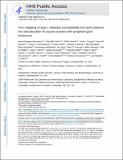Fine mapping of type 1 diabetes susceptibility loci and evidence for colocalization of causal variants with lymphoid gene enhancers
Author(s)
Onengut-Gumuscu, Suna; Chen, Wei-Min; Burren, Oliver; Farber, Emily; Szpak, Michal; Schofield, Ellen; Achuthan, Premanand; Guo, Hui; Stevens, Helen; Kundaje, Anshul; Kellis, Manolis; Deloukas, Panos; Wallace, Chris; Concannon, Patrick; Cooper, Nick J.; Quinlan, Aaron R.; Mychaleckyj, Josyf C.; Bonnie, Jessica K.; Fortune, Mary D.; Walker, Neil M.; Ward, Lucas D.; Daly, Mark J.; Barrett, Jeffrey C.; Cooper, Jason D.; Todd, John A.; Rich, Stephen S.; ... Show more Show less
DownloadKellis_Fine mapping.pdf (1.013Mb)
PUBLISHER_POLICY
Publisher Policy
Article is made available in accordance with the publisher's policy and may be subject to US copyright law. Please refer to the publisher's site for terms of use.
Terms of use
Metadata
Show full item recordAbstract
Genetic studies of type 1 diabetes (T1D) have identified 50 susceptibility regions, finding major pathways contributing to risk, with some loci shared across immune disorders. To make genetic comparisons across autoimmune disorders as informative as possible, a dense genotyping array, the Immunochip, was developed, from which we identified four new T1D-associated regions (P < 5 × 10[superscript −8]). A comparative analysis with 15 immune diseases showed that T1D is more similar genetically to other autoantibody-positive diseases, significantly most similar to juvenile idiopathic arthritis and significantly least similar to ulcerative colitis, and provided support for three additional new T1D risk loci. Using a Bayesian approach, we defined credible sets for the T1D-associated SNPs. The associated SNPs localized to enhancer sequences active in thymus, T and B cells, and CD34[superscript +] stem cells. Enhancer-promoter interactions can now be analyzed in these cell types to identify which particular genes and regulatory sequences are causal.
Date issued
2015-03Department
Massachusetts Institute of Technology. Computer Science and Artificial Intelligence Laboratory; Massachusetts Institute of Technology. Department of Electrical Engineering and Computer ScienceJournal
Nature Genetics
Publisher
Nature Publishing Group
Citation
Onengut-Gumuscu, Suna, Wei-Min Chen, Oliver Burren, Nick J Cooper, Aaron R Quinlan, Josyf C Mychaleckyj, Emily Farber, et al. “Fine Mapping of Type 1 Diabetes Susceptibility Loci and Evidence for Colocalization of Causal Variants with Lymphoid Gene Enhancers.” Nat Genet 47, no. 4 (March 9, 2015): 381–386.
Version: Author's final manuscript
ISSN
1061-4036
1546-1718